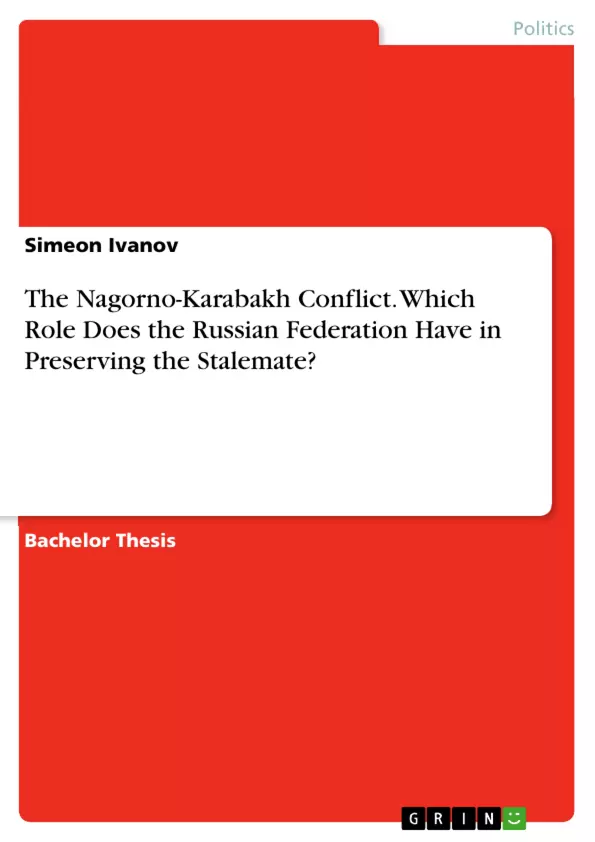This longitudinal study at the intersection of conflict studies and international relations aims to analyse the motives of the Russian Federation and its role in the preservation of the current status-quo of the conflict between Armenia and Azerbaijan over the Nagorno-Karabakh region. The main arguments of the thesis derive from international relations theories (realism in particular) and the results put emphasis on geopolitical and economic incentives. Moreover, the thesis pays attention to the background of the conflict, as well as the relations between the three states. The general results can help to analyse other conflict in which the Russian Federation is involved as a third party.
The deep origins of the conflict can be traced to almost a century ago, when in 1921 (some sources suggest 1923 or 1924) the Soviet Union made Nagorno-Karabakh an autonomous region within the Azerbaijan Soviet Republic, although the majority of the population was Armenian. The first tensions arose during the 1970s and the Gorbachev`s policies of perestroika and glasnost during the late 1980s gave extra momentum of the Karabakh-Armenians` movement, which desire was to unite with the Armenian SSR. The demand of the parliament of Nagorno-Karabakh to unify with Armenia in February 1988 sparked Azerbaijani aggression and in result, inter-ethnic violence sharpened and militia groups in both republics started ethnic cleansings.
The conflict erupted in August 1990, when Armenia declared its independence from the Soviet Union, claiming the Nagorno-Karabakh region as its territory. In response, Azeri and Soviet troops tried to disarm Armenian militias in the region, which was accompanied by skirmishers along the Azeri-Armenian border and within the secessionist entity. However, in September 1991 Nagorno-Karabakh declared its own independence, fully supported by Armenia, whereas Azerbaijan proclaimed direct presidential rule over the secessionist entity.
The all-out war started with the dissolution of the Soviet Union in December 1991 and the official independence of Armenia and Azerbaijan and lasted until May 1994, when a Russian brokered ceasefire was signed. However, over the next years fighting occurred periodically, despite the agreement, the diplomatic efforts and the meetings between the Azerbaijani and Armenian presidents.
Inhaltsverzeichnis (Table of Contents)
- Introduction
- Chapter 2: The Conceptual Framework and Literature Review
- 2.1 Concepts
- 2.1.1 National Interest
- 2.1.2 Spheres of Influence
- 2.1.3 Geopolitics
- 2.1.4 Conflict Stalemate
- 2.1.5 Conflict Management
- 2.1.6 Conflict Resolution
- 2.2 Literature Review
- 2.2.1 The Yugoslav War(s)
- 2.2.2 The Transnistria Conflict
- 2.2.3 The Nagorno-Karabakh Conflict
- 2.1 Concepts
- Chapter 3: The Theoretical Framework and Conflict Background
- 3.1 Theories
- 3.2 Background of the Nagorno-Karabakh Conflict
- 3.2.1 Armenian-Azerbaijani Relations
- 3.2.2 Armenian-Russian Relations
- 3.2.3 Azerbaijani-Russian Relations
- Chapter 4: The Analysis of the Russian Incentives
- 4.1 The Geopolitical Importance of the Caucasus for Russia
- 4.2 The Geopolitical Importance of the South Caucasian States
- 4.3 Channels of Russian Influence in the South Caucasus
- 4.4 Russian Economic Benefits from Maintaining the Nagorno-Karabakh Conflict
- 4.4.1 Russian Arms Selling Business
- 4.4.2 Russian Geo-energy Benefits
- 4.5 Security Dimension of the Nagorno-Karabakh Conflict
- Conclusion
Zielsetzung und Themenschwerpunkte (Objectives and Key Themes)
This thesis examines the role of the Russian Federation in preserving the status quo of the Nagorno-Karabakh conflict. It aims to uncover the motivations behind Russia's involvement and analyze the benefits it derives from maintaining the stalemate. The study focuses on the period from the early 2000s to the present, analyzing Russia's foreign policy under President Putin.
- The geopolitical importance of the Caucasus for Russia
- The role of Russia as an external actor in the Nagorno-Karabakh conflict
- The economic benefits of maintaining the conflict for Russia
- The security dimension of the conflict and Russia's interests
- The application of international relations theories to explain Russia's behavior
Zusammenfassung der Kapitel (Chapter Summaries)
- Introduction: This chapter sets the stage for the research by outlining the existing literature on the Nagorno-Karabakh conflict and highlighting the gap this thesis aims to fill. It introduces the research question, the analytical framework, and the timeframe of the study.
- Chapter 2: The Conceptual Framework and Literature Review: This chapter defines key concepts such as national interest, spheres of influence, geopolitics, conflict stalemate, conflict management, and conflict resolution. It then provides a comprehensive overview of relevant literature on the Yugoslav War(s), the Transnistria Conflict, and the Nagorno-Karabakh Conflict, emphasizing the focus on Russia's role and interests in each case.
- Chapter 3: The Theoretical Framework and Conflict Background: This chapter introduces the theoretical framework for analyzing Russia's involvement in the Nagorno-Karabakh conflict. It also provides a historical background of the conflict, outlining Armenian-Azerbaijani relations, Armenian-Russian relations, and Azerbaijani-Russian relations.
- Chapter 4: The Analysis of the Russian Incentives: This chapter delves into the core of the study, analyzing the benefits for Russia from preserving the stalemate. It examines the geopolitical importance of the Caucasus for Russia, the channels of Russian influence in the South Caucasus, and the economic and security benefits derived from maintaining the conflict.
Schlüsselwörter (Keywords)
The main keywords and focus topics of this work include the Nagorno-Karabakh conflict, Russia, conflict stalemate, geopolitics, national interest, spheres of influence, economic benefits, security interests, and international relations theories.
- Citation du texte
- Simeon Ivanov (Auteur), 2018, The Nagorno-Karabakh Conflict. Which Role Does the Russian Federation Have in Preserving the Stalemate?, Munich, GRIN Verlag, https://www.grin.com/document/468582



